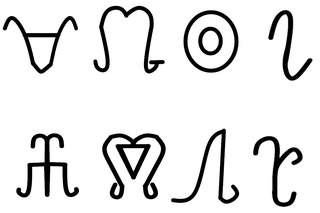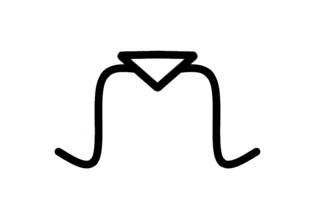
The Circassians or Circassian people, also called Cherkess or Adyghe are a Northwest Caucasian ethnic group and nation who originated in Circassia, a region and former country in the North Caucasus. As a consequence of the Circassian genocide, which was perpetrated by the Russian Empire during the Russo-Circassian War in the 19th century, most of the Circassian people were exiled from their ancestral homeland and consequently began living in what was then the Ottoman Empire—that is, modern-day Turkey and the rest of the Middle East. In the early 1990s, the Unrepresented Nations and Peoples Organization estimated that there are as many as 3.7 million Circassians in diaspora in over 50 countries.

Adyghe is a Northwest Caucasian language spoken by the western subgroups of Circassians. It is spoken mainly in Russia, as well as in Turkey, Jordan, Syria and Israel, where Circassians settled after the Circassian genocide by the Russian Empire. It is closely related to the Kabardian language, though some reject the distinction between the two languages in favor of both being dialects of a unitary Circassian language.

Circassian, also known as Cherkess, is a subdivision of the Northwest Caucasian language family, spoken by the Circassian people. There are two Circassian languages, defined by their literary standards, Adyghe, with half a million speakers, and Kabardian, with a million. The languages are highly mutually intelligible with one another, but differ to a degree where they would be considered clear-cut dialects. The earliest extant written records of the Circassian languages are in the Arabic script, recorded by the Turkish traveller Evliya Çelebi in the 17th century, although the Greek and Georgian alphabets were adapted for them in ancient and medieval times.

The Ubykh are one of the twelve major Circassian tribes, represented by one of the twelve stars on the green-and-gold Circassian flag. Along with the Natukhai and Shapsug tribes, the Ubykh were one of three coastal Circassian tribes to form the Circassian Assembly in 1860. Historically, they spoke a distinct Ubykh language, which never existed in written form and went extinct in 1992 when Tevfik Esenç, the last speaker, died.

The Kabardians or Kabardinians are one of the twelve major Circassian tribes, representing one of the twelve stars on the green-and-gold Circassian flag. They are also commonly known by the plural terms Kabardin, Kebertei, or Kabarday. Along with the Besleney tribe, they speak a distinctive dialect of the Circassian. Historically the Kabardians lived in Kabardia, a region of the north Caucasus. In modern times the Kabardians live mostly in the Russian republic of Kabardino-Balkaria, which partly corresponds to the historic region.
Hakuchi is a variety of the Shapsug sub-dialect of West Adyghe dialect of the Adyghe language spoken in Turkey.

The Hatuqway are one of the twelve major Circassian tribes, representing one of the twelve stars on the green-and-gold Circassian flag. They were known for their art of war as a warrior tribe. After the Russo-Circassian War, their presence in the Caucasus was destroyed during the Circassian genocide, and their number was significantly decreased and today they exist only in small communities in various diasporas, and their names are not mentioned anymore in Circassian dialectology.

The Shapsug are one of the twelve major Circassian tribes. Historically, the Shapsug tribe comprised one of the largest groups of the Black Sea Adyghe. They inhabited the region between the Dzhubga River and the Shakhe Rivers and high-altitude mountainous areas of the northern slopes of the Caucasus range along the Antkhir, Abin, Afips, Bakan, Ships, and other rivers . In Russia, the remaining Shapsug population mainly live in the Tuapsinsky District (Tuapse) of Krasnodar Krai, Lazarevsky City District of Sochi, and in the Republic of Adygea, which were a small part of historical Circassia.
The Abzakh are one of the twelve major Circassian tribes, representing one of the twelve stars on the green-and-gold Circassian flag. Historically, they lived in the mountainous part of the modern Russian republics of Adygea and Krasnodar Krai. Major settlements or villages were located in the river valleys Kurdzhips, Psheha, Pshish, and Psekups.
Proto-Circassian is the reconstructed common ancestor of the Adyghean and Kabardian languages.

The Bzhedugh are one of the twelve major Circassian tribes.
Adyghe is a language of the Northwest Caucasian family which, like the other Northwest Caucasian languages, is very rich in consonants, featuring many labialized and ejective consonants. Adyghe is phonologically more complex than Kabardian, having the retroflex consonants and their labialized forms.

The Chemirgoy or Temirgoy are one of the twelve major Circassian tribes, representing one of the twelve stars on the green-and-gold Circassian flag. They lived between the lower flows of the Belaya and Laba Rivers and their lands extended north to the Kuban. After the end of the Caucasian War, most Temirgoys resettled in other Circassian villages, as well as in Turkey and in other parts of the Middle East. In Turkey, the majority of the population of the village Hadzhimukohabl are Temirgoy.

The Besleney are one of the twelve major Circassian tribes, representing one of the twelve stars on the green-and-gold Circassian flag. By character, culture and language, the Besleney are closest to Kabardians. The noble families of the Besleney were Kanoko and Shaloho, ancestors of Kabardian Prince Beslan,, who established his own tribe of the same name.
The Mamkhegh or Mamheg were one of the twelve major Circassian tribes, representing one of the twelve stars on the green-and-gold Circassian flag.
The Zhaney, or Jane, were one of the twelve major Circassian tribes, representing one of the twelve stars on the green-and-gold Circassian flag.
The Shapsug dialect is a dialect of Adyghe. The Shapsug dialect is spoken by the Shapsugs, which are one of the largest Circassian population in the diaspora outside Republic of Adygea, alongside Abzakhs. The Shapsug dialect is very similar to the Natukhai dialect and together, they make the Black Sea coast dialects of Adyghe. The Shapsug dialect consists of three main sub dialects: Great Shapsug, Small Shapsug and Hakuchi. The Shapsug dialect is best known as the dialect with palatalized velar stops.
The Bzhedug dialect is a dialect of Adyghe. The Bzhedug dialect is spoken by the Bzhedugs who live mostly in Adygea and Biga.
The Besleney Kabardian dialect is one of the East Circassian dialects and usually considered a dialect of Kabardian. However, because the Besleney tribe lived at the center of Circassia, the Besleney dialect also shares a large number of features with dialects of Western Circassian.
The Yegeruqway were one of the twelve major Circassian tribes, representing one of the twelve stars on the green-and-gold Circassian flag. There is also a small town with a form of the same name Egerukhay in the Koshekhablsky District, Adygea, Russia.













